When and how to plant plums in spring and autumn
Plums can be grown throughout Russia, however, not all gardeners achieve success and large yields, but mainly residents of regions with short summers. The fact is that plum is a rather thermophilic stone fruit crop, which means that mistakes in choosing a variety and planting often lead to rather modest results.
Therefore, below you will find out all the information on how to properly plant a plum in spring and autumn, so that in the future the tree can bear fruit abundantly and give high yields.
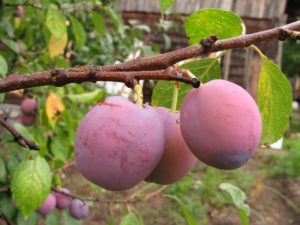
Content
When is it better to plant plums - in spring or autumn
However, planting plums in spring has some obvious benefits:
- In the process of growing a seedling in a warm period, you can quickly respond to all possible problems (diseases, pests, lack of moisture) and immediately take the necessary measures to eliminate them.
- The spring supply of moisture in the soil will allow the root system of the seedling to adapt faster after planting and begin active growth.
- You have the opportunity to prepare a planting hole in advance, even in the fall, so that the soil has time to settle by spring, in order to avoid deepening the root collar when planting.
Alternative opinion
However, if you are a resident of the South of Russia, then this is not important for you. It is a different matter if you are from a region with a more severe (northern) climate.
There is even an opinion that in the southern regions it is better to plant all crops in the fall, and in the northern ones only in the spring.
Video: in what time frame is it better to plant seedlings of fruit and berry crops
Planting plums in spring and autumn: optimal timing
Well, we have sorted out several points of view on the subject of when it is better to plant plums - in spring or autumn. The decision is yours!
Note! Plum seedlings with a closed root system (in a container) can be planted all year round - from April to October, unless it is recommended to do this in the middle of summer, when it is very hot.
Next, it's time to familiarize yourself with the specific recommended dates for planting plums in spring and autumn in different regions.
Spring planting
So, you need to have time to plant a plum in the spring. before budding on the seedling, in other words, before it enters the growing season (i.e. the plant must still sleep).
At the same time, an important condition for a successful spring planting is positive air temperature, and not only during the day (it should already be +5), but also at night.
Advice! Don't wait for the ground to completely thaw out. It is very good to plant seedlings with an open root system immediately after the snow melts, but the ground has not yet had time to warm up and dry very much.
Thus, it is highly desirable to have time to plant while the seedlings are still "dormant", otherwise it will definitely negatively affect their survival rate and disrupt their natural development cycle.
By the way! The best time to plant seedlings is cloudy and calm weather: early morning or late evening.
As for the approximate dates, depending on the climatic characteristics of the region, spring planting of plums is recommended from late March-April to early-mid May:
- So, in the south of Russia, plum seedlings can be planted in open ground in the second half of March and early April.
- In the Middle Polos (Moscow region), the plum is planted not earlier than the second half of April.
- In Siberia and the Urals, spring plum planting is carried out in late April-early May.
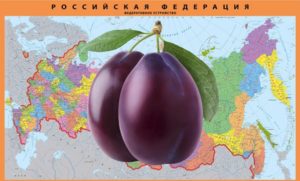
Autumn planting
The main rule when determining the optimal timing for autumn planting is to calculate when stable frosts will come, and plant it 3-4 weeks before them, i.e. you should have about a month in stock. The fact is that the seedlings must have time to root well before the onset of cold weather and successfully prepare for winter, and this will take time.
However! Too late to plant seedlings in the autumn is also not recommended, because shoots must have time to mature well in order to successfully survive the winter.This is especially true for planting plums in cold (northern) regions, in the same Siberia.
However, if, God forbid, you are late, and frosts are expected within 1-2 weeks, then it is better to play it safe and postpone planting the plum until spring (you can save the seedling by digging it in the garden and covering it or planting it in a container and putting it in the basement, where the temperature is kept no higher than +3 degrees).
Interesting! Many experienced agronomists recommend plant plums in the spring and buy seedlings in the fallsince their choice is wider, and the quality is much higher.
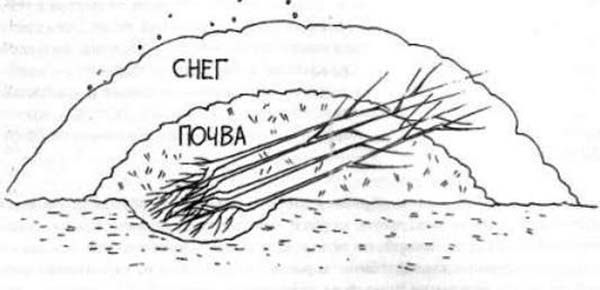
Thus, depending on the climatic characteristics of the region, the autumn planting of plums is recommended from September to the end of October:
- So, in the South of Russia, plums can be planted until late autumn — until the second half of October.
- Gardeners of the Middle Strip (Moscow Region) should have time to plant plums in autumn before the end of September (maximum - in early October).
- In colder regions - in the North-West (in the Leningrad region), as well as in Siberia and the Urals, plums are planted in early autumn - in the first half of September.
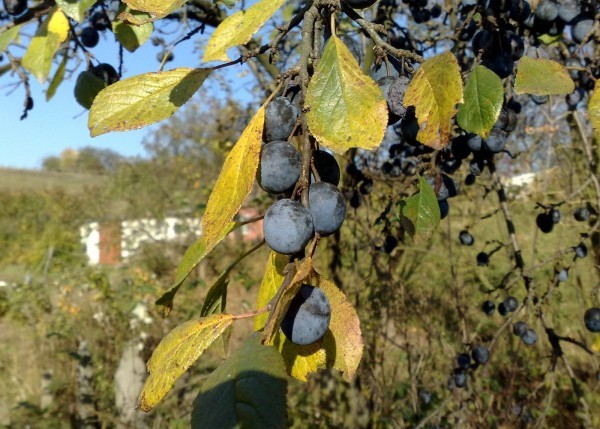
Video: planting plums in autumn in October from a container
According to the lunar calendar in 2020
Choose the optimal date for planting seedlings can help you moon calendar.
So, favorable days for planting plums in spring and autumn in 2020 according to the lunar calendar are:
- in March - 26-29;
- in April - 11-15, 24, 25;
- in May - 2-10;
- in September - 19-26;
- in October - 3-13, 18-21.
Of course, it is not always possible to get to the dacha on favorable days, so the main thing is not to land on unfavorable dates according to the lunar calendar - the days of the New Moon and Full Moon, as well as the period when the Moon is in Aquarius, because it is a barren and dry sign -in italics.
Unfavorable days, according to the lunar calendar for 2020, for planting plum seedlings, the following dates are:
- in March - 9,19-21, 24;
- in April - 8,15-17, 23;
- in May - 7,13-14, 22;
- in June - 5,9-11, 21;
- in July - 5,7-8, 20;
- in August -3, 4-5, 19, 31;
- in September -1, 2, 17, 27-28;
- in October - 2, 16,24-26, 31;
- in November - 15,20-22, 30.
According to the lunar calendar, from the magazine "1000 Tips for Summer Residents".
How to plant a plum correctly: instructions from A to Z (choosing a seedling, a place in the garden, preparing a planting pit)
Before rushing headlong for a seedling to the market or garden fair, you need to carefully study all the rules for choosing a plant, as well as choosing a place in the garden and preparing a planting pit.
What should be a seedling
When choosing a planting material (a specific variety), first of all, you need to pay attention to its origin. Best to choose zoned varieties draining yourself well recommended when grown in your climate zone, i.e. they adapted to weather conditions and the soil composition of your growing region.
Worth knowing! Saplings can be either with an open root system (OCS), and with a closed one (in a container).
It is better for beginner gardeners to buy seedlings in a container (although they are more expensive), and experienced ones can also purchase them with ACS.
A quality plum sapling should have the following characteristics:
- General appearance seedling should be healthy, without signs of wilting, damage by diseases or pests.
- The seedling itself must be not older than 2 years (1-2 years of age), since at this age the seedlings adapt faster to a new place.
- Height seedling should be within 1-1.5 m: any deviation up or down indicates improper maintenance or excessive nitrogen fertilization.
Another thing is that some sellers immediately sell cut seedlings, but this is rare.
- The seedling must have well developed root system (without any growths and neoplasms), that is, in addition to the main root, there should be several more lateral roots (the older the seedling, the more roots it has), the length of which can be about 20-25 cm, while they should not be overdried and broken.
By the way! Even if you are buying a seedling with a closed root system, you may want to consider lateral roots because they tend to stick out of the container.
Advice! And to check that the seedling really has a closed root system, you need to take it by the trunk and shake it. If it sits tightly - everything is fine, if not, then something is wrong here ... the seller just wants to cash in on you by slipping a seedling from the ACS, which he moved into a container a couple of days ago.
- At the bottom, on the trunk, you should clearly see vaccination site (connections of rootstock and scion), which will guarantee that this is a varietal tree, and not wild.
As a rule, the vaccination is done by budding method (they also say "grafted with an eye"), less often with a handle (ie copulation).
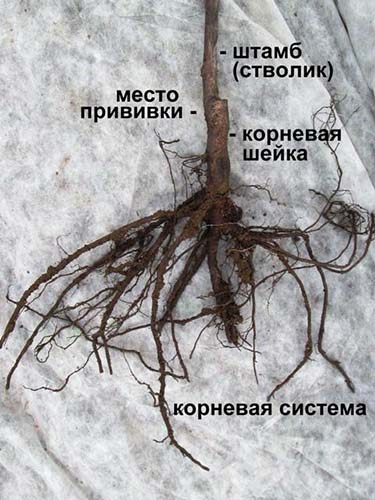
- It is also worth evaluating the quality of the upper part of the trunk (grafted part): the wood must be ripe and strong, without any mechanical damage, sunburn, frost cracks and cracks in the bark. And you the trunk must be straight and not bent.
Note! If the bark on the trunk peels off in places without damaging its integrity, then this is a sign of improper storage of the seedling in winter, which led to its freezing.
- It is highly desirable that the seedling did not show any signs of the beginning of the growing season, i.e. was in a dormant stage, which means that its buds should still be sleeping (i.e. there should not be leaves on it).
Important! This applies to the selection and purchase of a seedling in the early spring period.
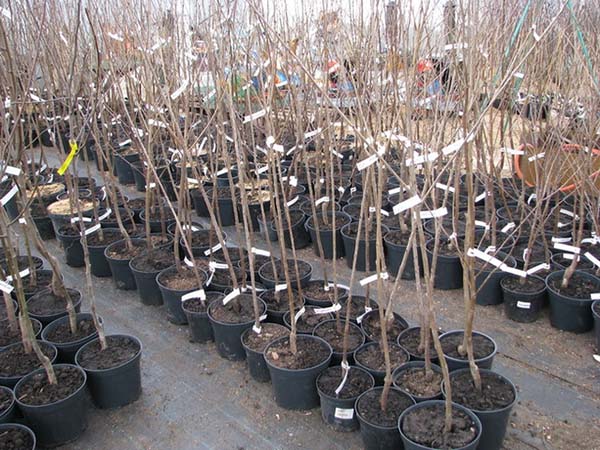
However, seedlings with a closed root system (in containers) in the spring are often sold already in the growing season, which is quite normal. Therefore, in this case, you also need to carefully evaluate their appearance, especially the color of the leaves.
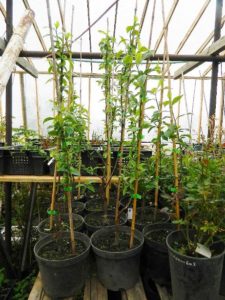
Video: how to choose a plum sapling
Preparing for landing
If you want to properly prepare the seedling for planting, then immediately before planting the plum, you should wash its roots from the old soil, then dip it in a clay mash, and then update their (roots) tips, slightly cutting.
Important! It is highly recommended to renew the root tips by trimming them if they are either too long or you notice that there are damaged, diseased or broken roots (in this case they need to be trimmed to a healthy place).
Some gardeners recommend completely soaking the seedling in water (with the addition of Kornevin) for a day or at least an hour. This will help restore biological processes in the roots and saturate them with moisture, especially if you see that the roots are slightly dry (and this should never be allowed).
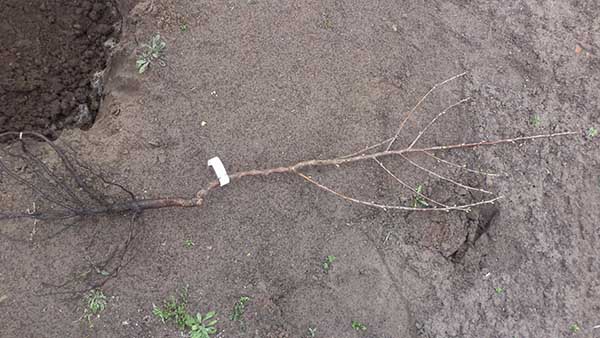
Landing place
Plum loves warmth and a lot of light, which means that this stone fruit crop will grow well and bear fruit abundantly only in open and well-lit areas of the garden.
The ideal option for planting plums will be a place that will be protected from the drying winter winds on the north side (this can be your country house, some kind of outbuilding or fence), while the tree itself, naturally, it should be placed on the south side (or at least from the south-west or west) so that during the day it receives the maximum amount of sunlight.
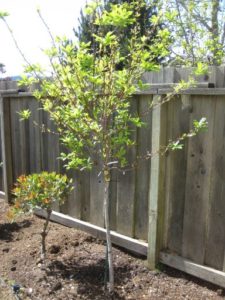
You can't plant a plum in the lowlandswhere melt water stagnates for a long time or wetlands. In other words, at the landing site moisture should not stagnate in the springwhen the snow melts. Otherwise, the plant will simply underpin the root collar, and its days will be numbered ..
The occurrence of groundwater in the area intended for planting plums should be at a level of 1.5-2 m from the ground surface.
Advice! If the groundwater is close, then you have no choice but to make an artificial embankment and plant a seedling on it.
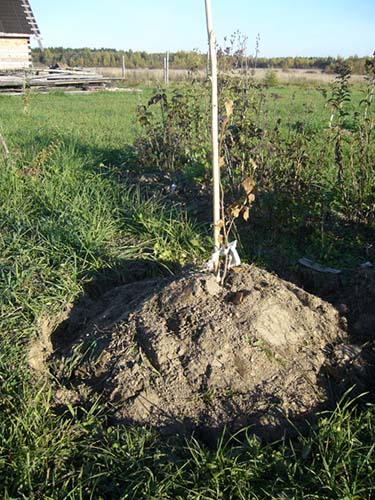
Important! Plums and other trees should not be planted near large, spreading trees (especially nut), since this always negatively affects their growth and productivity (if the seedling can generally grow and bear fruit normally).
At what distance
You have chosen the place, now you need to decide on the landing pattern.
If you want to plant several seedlings at once, then it is recommended to plant plums according to the scheme - 3 by 3, i.e. the distance between seedlings in a row and between rows should be 3 meters.
Advice! It is necessary to retreat to exactly the same distance from other plants on the site so that the wide crown of the plum does not shade them in the future.
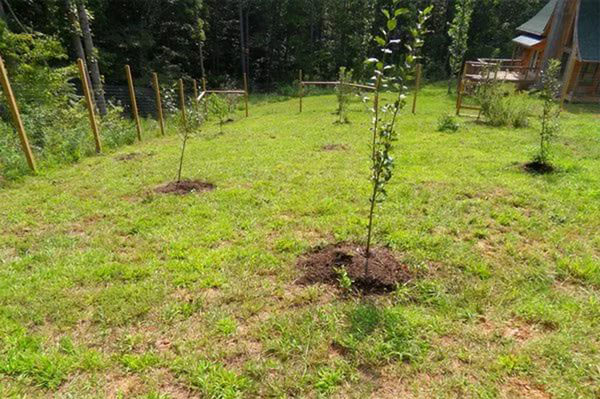
Remember! The closer you plant trees, the more difficult it will be for you to control their crown in the future, in other words, you will need regular and mandatory pruning, including summer pruning.
You also need to take into account the fact that some varieties of plum are not capable of self-pollination (self-fertile), therefore, they should be planted only in groups (at least two, and preferably three different varieties).
Required soil
To count on good growth and stable yields, the soil under the plums must have high fertility, be light and loose (water and breathable), and also have neutral acidity.
Worth knowing! All stone fruits love non-acidic soils and will thrive better in alkaline soils (7-7.5 pH) than even relatively acidic (5.5 pH).
The most suitable soil types for plums are the following: loams, peat bogs (but only deoxidized, i.e. limescale = acidity reduced to neutral) and sod-podzolic.
Of course, the most unfortunate option for planting plums (and almost all fruit trees) is a purely sandy and clayey soil.
Important! When planting a seedling in excessively sandy soil, add a little clay and more compost to it, and sand in clayey soil, this will help balance the composition of the soil.
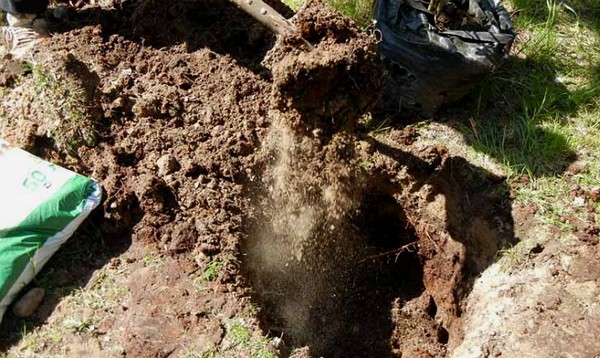
Advice! In a cold and harsh climate, as well as if the land is heavy, or the site is very waterlogged and the groundwater is very close, then the plum (like any other fruit trees, especially stone fruit trees) is recommended to be planted on gentle hills ("According to Zhelezov").
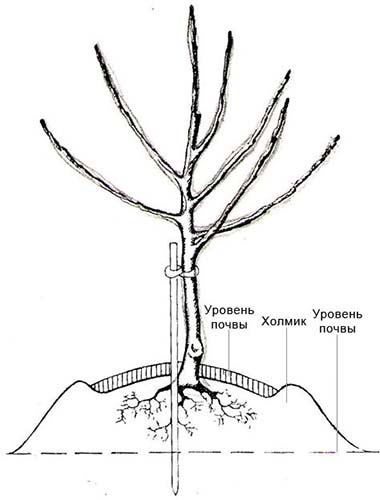
Video: planting a plum sapling in Siberia on a hill
Planting pit preparation: optimal dimensions
Naturally, as always, it is recommended to prepare a planting hole for planting a plum sapling or any other plant in advance. It is best to do this in the fall or at least 1-2 weeks before planting the seedling. During this time, the soil will just have time to settle to the desired level.
Important! When digging a planting hole, the top layer of soil is thrown aside for further use.
Width (diameter) and depth of the planting pit for all fruit trees must be within 50-80 cm. In this case, the walls of the recess should not taper downward: it is better to make them vertical.
By the way! As a rule, on average, they dig a hole of 60 by 60 cm.However, for planting plums, many it is recommended to dig a hole 1 meter wide and 60-80 cm deep.
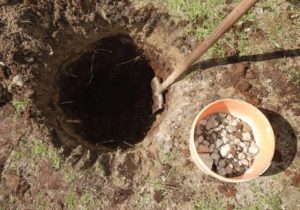
And here is a planting hole for a seedling closed root just do 2-3 times larger than the container itself.
If necessary, it is immediately laid on the bottom drainage layer 5-15 cm from broken bricks or small stones (it is optimal to use lime or chalk crushed stone, in which there is a lot of calcium and which perfectly deoxidizes the soil = lowers its acidity), and then the prepared nutrient mixture is poured.
Important! If you have to plant in clay soil, then, in addition to the obligatory drainage layer, you also need to dig the deepest hole possible.
How (with what fertilizers) to fill the planting pit - we prepare a nutritious substrate
So that a plum sapling can easily adapt to a new place and begin to grow actively, it is recommended to fill the planting pit with a nutritious substrate when planting it.
To do this, it is recommended to pour a specially prepared soil mixture into the planting pit (which is thoroughly mixed until a uniform consistency). The nutrient substrate is usually prepared from the following components (mineral and organic fertilizers):
- all horse fertile soil (upper 20-30 cm), which you removed when digging a hole;
- a bucket (8-9 kg) of good humus or compost;
Additionally:
- a bucket (8-9 kg) of non-acidic peat (purely at will and opportunity, or in case you have sandy soil);
- a bucket (8-9 kg) of sand (if you have relatively heavy / clay soil);
- 1-2 cups (200-500 grams) superphosphate or 400-600 grams of bone meal (organic phosphorus fertilizer);
- half or 1 cup of potassium sulfate (100-200 grams) or 2-4 cups (200-400 grams) wood ash (organic analogue of potash fertilizer).
Or, instead of superphosphate and potassium sulfate, you can take 300-400 grams of nitroammophoska (it contains 16% nitrogen, phosphorus and potassium) or diammophoska (10:26:26). At the same time, it is better to use nitroammophoska for spring planting, and diammophoska for autumn planting.
Worth knowing! When planting a tree (even in spring), it is not necessary to specially add nitrogen fertilizers (another thing if it is a complex fertilizer), since they stimulate the growth of the aboveground part to the detriment of the development of the root system (especially when planting in northern regions).
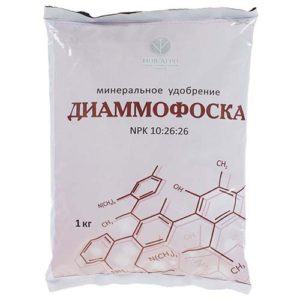
Important! However, some gardeners and agronomical scientists do not recommend at all to lay mineral fertilizers in the planting pit, but advise to apply them in the future and already as top dressing, because it is believed that the plant (seedling) does not need fertilizers until it begins to bear fruit. Another thing is organic fertilizers such as compost, wood ash, bone meal.
After filling the pit with a nutrient substrate in its middle, it is necessary drive in a wooden peg, which will further serve as a support for a young seedling.
Note! If you do not tie a young seedling to a peg, then when leaves grow on it, due to its high windage, strong winds will sway the trunk and cut off young roots.
Direct phased planting of a seedling
Step-by-step instructions for planting a plum sapling in open ground in spring and autumn:
- Fill the planting hole with fertile soil in advance, leaving a depression to the size of the root system of the seedling.
Further, if desired (many water only after planting, others both before and after, in other words, as you like best), you can slightly spill a hole filled with nutrient soil with water.
- If you are planting a seedling with an open root system (ACS), then you need to add a small mound in the center of the planting hole.
Another thing is if you are planting a seedling with a closed root system (ZKS). In this case, you do not need to make any mounds, but simply plant the seedling in the prepared planting pit, without disturbing the earth clod.
- Drive in a wooden support or peg (if you have not done so beforehand).
If you do not tie a young seedling to a peg, then when leaves grow on it, due to the high windage, strong winds will sway the trunk and cut off young roots.
- Place the seedling in the center of the mound and spread the roots along its (mound) sides down (the roots should in no case bend and stick up!), Because the roots should be placed in the pit as comfortably as possible for them, without twisting or bending.
Advice! If you have a seedling that was grafted with an eye (budding), then the budding site (eye = new shoot that grew from the grafting) should face north and the cut site should face south.
- Cover with earth, while shaking the seedling to eliminate voids between the roots.
Remember that the grafting site should initially be located 10 centimeters above the soil level. At the same time, it is convenient to control the landing level with a rail, which must be placed horizontally on the sides of the pit, when the pit is almost filled with soil.
- Compact (tamp) the soil, starting from the edges at the base of the seedling.
Important! Do not confuse the root collar (the place where the first root originates from the trunk) with the graft, which is higher (on the trunk) and, as a result, should be 3-5 cm (you can just put 2-3 fingers) above the soil surface. After the tree settles in loose soil, the root collar will in any case take its normal position.
Attention! If you deepen the root collar, the tree will grow poorly and gradually die (because the root collar will shake out). On the contrary, if you plant too high, the roots of the seedling will be exposed and may simply dry out in the heat of summer or freeze in winter.
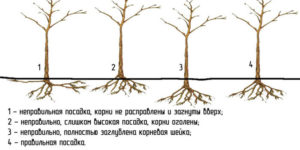
- Next, you need to make a hole (roller) along the diameter (perimeter) of the trunk circle 5-10 cm high.
- Spill abundantly with water, pouring out at least 2-3 buckets (pour out gradually - wait for it to be absorbed and add more).
- Tie the seedling to the prepared support with a soft twine and secure in the correct position.
- Smooth out the roller, loosen the soil in the trunk circle and mulch it with peat, humus or compost.
Mulch will help to avoid drying out the roots and excessive evaporation of moisture.
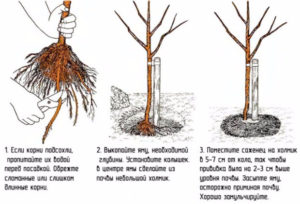
Note! Mulch should not be laid close to the stem of the seedling, as this can cause the bark to undergo heating, and, consequently, cause the development of fungal diseases.
In any case, the grafting site should be above the mulch.
Video: how to plant a plum
Plum care after planting: basic activities
Immediately after planting, a plum sapling must trim, in order to level the root system with the aboveground part (this is done for a kind of "resuscitation" of the seedling after planting, since any planting and transplantation is an injury and stress for the plant).
How to prune plums after planting in spring or autumn?
- You need to leave the main trunk 50-60 cm high, making a cut above the healthy kidney.
If there are side shoots, then they also need to be shortened, leaving 2 buds each.
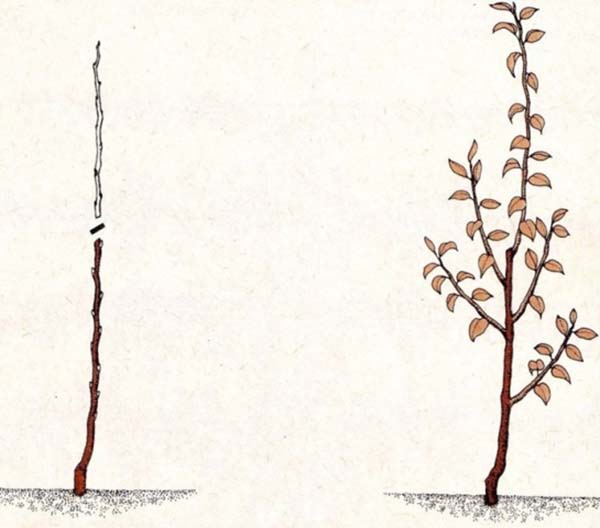
Further, the young tree will need careful post-plant care from you, aimed at creating optimal conditions for its early survival in a new place.
It is not unreasonable to say that one of the main conditions for the successful rooting of plums is a sufficient amount of moisture in the soil. Therefore, if the weather is dry, then after planting, timely and regular watering should be carried out (1-2 times a week), pouring out 2-3 buckets of water. In the future, watering will need to be carried out as needed, depending on the weather conditions (in spring and autumn, you can water 2-3 times a month, and in the hot and dry summer period - once a week). And after each watering, if you have not mulched the trunk circle, it is recommended loosen the soil at the baseto improve oxygen access to the roots and at the same time weed the weeds off the trunk circle.
By the way! It is very simple to determine that the earthen lump has dried out and urgently needs watering: dig a hole deep into the bayonet of a shovel (25-30 cm), take a handful of earth from the bottom, and if it is dry, then water it urgently.
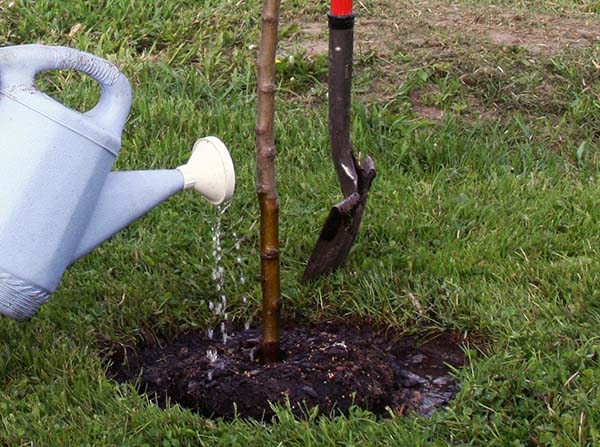
Advice! Either make a new hole every year, or initially dig not very deep (maximum - 3 cm) so that moisture does not accumulate in it in the winter-early spring period and the root collar does not get wet and melt away.
Additional dressings during this season, it is no longer necessary to carry out, since all the necessary nutrients were introduced even during planting, and they should be enough for the next few years (2-3 years).
And if in the future you don't like the variety or want to have several different varieties on the same tree at the same time, You can plant plum in one of the known ways.
Important! The site has a detailed article about when and how to plant a plum correctly.
Of course it takes closely monitor the condition of your treeso that he is not suddenly struck by any diseases, pests do not attack.
The most annoying diseases that affect the plum (as well as cherry plum) are clotterosporia (perforated spot) and polystygmosis (plum red spot or cherry plum).
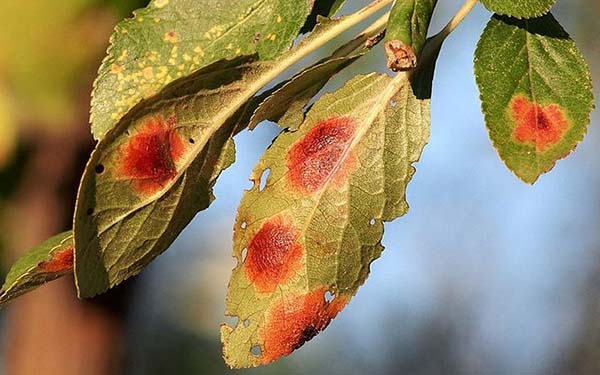
By the way! The site has a detailed article about how to properly spray fruit trees (including plums) and berry bushes in the spring against diseases and pests.
If the plum is attacked by aphids, then in the fight against this malicious pest of fruit trees you will help our material.
And in the fall, do not forget to properly prepare the plum for winter.... In particular, it is important to mulch and slightly cover (warm) young seedlings.
By the way! The site has old material about what to do with plums in autumn and how to prepare them for winter.
And next spring, you will again have to perform a series of simple activities to care for your stone fruit crop.
Well, now you know everything you need to properly plant a plum in spring and fall, as well as what will be needed in the post-planting period. A few years later, the plum will certainly thank the owner in full for the care rendered with an abundant harvest of sweet plum fruits.
Video: how to plant a plum correctly


Well, what can I say, I made a request when in what month to plant plums in the fall, I did not receive an answer, you can answer by e-mail.
Good day! What region (oblast) do you live in? The material provides approximate dates for the most common regions and regions, but first of all, one should rely on current weather conditions and a medium-term weather forecast.